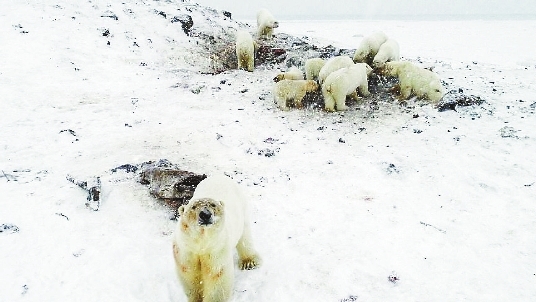
DOZENS of polar bears have crowded a village in Russia’s far east in search of food, forcing public events to be canceled and humans to shelter inside. About 60 polar bears descended on Ryrkaypiy in Russia’s remote Chukotka region, Tatyana Minenko, the head of the village’s “bear patrol,” told Russian state news agency RIA Novosti. The polar bears were eating the carcasses of walruses that had remained on the village’s shores since the fall, the Russian branch of the World Wide Fund for Nature (WWF) said Thursday in a statement. “Almost all of the bears are thin,” said Minenko in the WWF statement. “Among them are both adults and young animals; there are females with cubs of different ages,” she said. Ryrkaypiy has a population of about 500 residents, according to state news agency TASS. It is situated near the shore of the Arctic Ocean and faces Wrangel Island, known to be a “maternity house” for polar bears, TASS said. Higher than usual temperatures are causing ice to melt, which is affecting the bears’ hunting habits, according to the WWF. “If the ice was strong enough, the bears, or at least some of them, would have already gone to sea, where they could hunt for seals or sea hares,” said Mikhail Stishov, coordinator of WWF-Russia projects for the conservation of Arctic biodiversity. “Similar situations are becoming the norm,” he said. “We need to adapt to this so that neither people nor bears suffer.” Volunteers and residents have started patrolling the area around the village, including schools and kindergartens, to avoid encounters with the unexpected guests, WWF said. All public events have been canceled and children are being transported to school in buses. “The psychological situation in (Ryrkaypiy) is complicated, women worry, because their children walk to school,” Anatoly Kochnev, a scientist at Russia’s Institute of Biological Problems of the North, told state news agency TASS. Fewer than five years ago, it would have been unusual to see a group of more than three to five polar bears near the village, Kochnev said. “We try to control the situation, but nobody would want to think what may happen there in three to five years,” Kochnev said. “If walruses abandon the cape or if their population reduces, polar bears would not stop to be there — but they will be hungry.” The polar bears have usually remained calm when they come close to people, Kochnev said. The last time a bear killed a human in Ryrkaypiy was in 2011, according to TASS. The news of the bear invasion comes in the same week that a video was shared on social media of a polar bear in Chukotka with graffiti spray-painted on its back. It’s not known why the animal was painted, but Kochnev said earlier it was probably the work of “pranksters.” (SD-Agencies) | 
